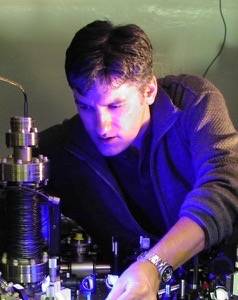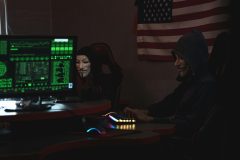On the surface, D-Wave’s quantum computer looks revolutionary. Google, NASA, and Lockheed Martin are all customers. The company has publishedarticleson its merits in 60 peer-reviewed scientific journals.
But a very vocal naysayer isn’t on board with the company’s claims—the scientific community.
Scientists accept that D-Wave has built a very fast computer. The controversy lies in D-Wave’s inability to satisfactorily convince physicists that its computer is actually harnessing the mindbending properties of quantum mechanics.
D-Wave CEO Vern Brownell says that scientists are still caught up in the theories of quantum computing, while D-Wave has moved on to practical applications. In the meantime, he said D-Wave’s scientific publications and star-studded customers should speak for themselves.
“We recognize controversy is out there, but the reality of any new groundbreaking technology is that controversy is always going to be out there,” he said.
But according to Christopher Monroe, the Bice Zorn Professor of Physics at the University of Maryland and fellow of the Joint Quantum Institute, it’s not the science community’s burden to prove. D-Wave will have to convince them first.
“It’s incredible they’ve been allowed to take it this far,” he said. “They do publish questionable papers, but they don’t publish data on the foundations of their system because they can’t.”
The Quantum Coffee Cup

Even for physicists, quantum mechanics can be a mind boggling field. Einstein famously thought the theory was too weird to be true. (He was wrong.)
Here’s the simplified theory for newcomers. In quantum mechanics, subatomic particles—and, under certain circumstances, collections of particles that have become “entangled” in a complex way—can have contradictory properties at the same time so long as no one’s looking. But when someone peeks, the system pops into a definite, but randomly determined, state.
This theory is where we get the paradox ofSchrödinger’s cat—a feline trapped in a chamber where a radioactive substance has a 50% chance of emitting a particle that will trigger the release of poison gas. Because that particle emission is a quantum event, the cat is both dead and alive at the same time—at least until someone opens the chamber to check on it.
In classical computing, the smallest denomination of a computer is a bit, which holds a value of 0 or 1. Quantum computing uses a “quantum bit”, called a qubit, which is valued at both 0 and 1 at once. When a qubit has two values at once, it’s said to be in a “quantum state.” If you build a machine with two qubits, it can be valued at 00, 01, 10, and 11 at the same time. As you add qubits, a quantum computer gains vastly more computing power than its classical analogue. Theoretically, at least.
Should it be what the company claims, D-Wave’s computer could be an enormous boon for society, harnessing tandem values to perform multiple equations in parallel, and solving enormous problems that have been too difficult for classical computing. At 512 qubits, it would be the largest ever quantum computer ever conceived. Research scientists who have published their work so far haven’t gotten beyond double digits.
The issue is that building qubits is very difficult, and keeping them in a quantum state is even tougher. According to the laws of quantum mechanics, each time you read data off a qubit—techically, an observation—it decoheres into a non-quantum state. It becomes merely a bit, valued at 0 or 1.
The scientific community accepts two models for building qubits and keeping them in quantum states—gate and adiabatic. D-Wave’s is adiabatic, and so is the 20-qubit model Monroe has in his lab. Adiabatic quantum computers apply quantum annealing—put simply, a strategy for finding the lowest-energy solution to a numerical problem.
There are tests to prove whether qubits reset to quantum, usually by reducing the machine down to two qubits and making a model. Since D-Wave hasn’t chosen to conduct such a test, scientists are skeptical.
“Nobody knows much about D-Wave,” said Duncan Steel, a professor of engineering at the University of Michigan. “The rumor is that they have now sold a few of their machines, but the customers are government funded to evaluate the machine. They won’t tell anyone how the machine works and so, even in principle, no one knows if it is possible that it might actually be a quantum computer.”
Perhaps the biggest breakthrough in D-Wave’s favor came in June when USC researchers published a paper titled “Experimental Signature of Programmable Quantum Annealing” in the peer-reviewed online journal Nature Communications. The paper posits “strong agreement” between a D-Wave machine and the laws of quantum mechanics, but to Monroe it means nothing.
“If you read [the paper], there is nothing in there that requires a quantum description of what’s going on.” he said. “It says that their machine is consistent with certain models based on quantum mechanics. Big deal: I’m quantum too, and so is this coffee cup. But Is there entanglement? Can they use it to compute? It doesn’t say. D-Wave dwells on certain aspects that are consistent with particular quantum models. But there are non-quantum models of what’s happening that describe all their data too.”
Too Good To Be True
The way Brownell describes D-Wave’s product, it sounds like something out of science fiction.
Picture a quantum processor the size of your fingernail, packed with superconducting wires. It sits in a magnetic vacuum, cooled to near absolute zero. It’s programmed by loading a set of mathematical equations into the processor. The processor then moves through near infinite possibilities before determining the lowest energy solution. When it arrives at that, it spits it out as the answer.
It’s a futuristic type of computing that could change the way we evaluate complicated financial or logistical problems. Cancer researchers believe it could be used to determine the behavior of proteins encoded by the human genome.
Based in Vancouver, D-Wave employs 110 people, mostly scientists and engineers, 30 of whom are PhDs. Some focus on nothing but researching papers for publication in scientific journals, the better to finally appeal to the scientific community.
Brownell thinks scientists may be concerned by the D-Wave’s position as a for-profit company, and questions about its quantum state may just be an inability to accept that D-Wave has been able to create something that years of quantum mechanics study has not.
“It’s commercial and it’s a business with the goal to become profitable and fuel scientific research—it’s a very different model than anyone else in the quantum computing community,” he said. “We’ll continue to reach out to the community, and publish papers. It’s hard to do that and build a product at the same time, but I think we’ve done a pretty good job. We’ve built something nobody else has been able to build.”
But D-Wave’s founder, Geordie Rose, takes a more lackadaisical approach. Maybe it doesn’t really matter if the company’s machine is actually a quantum computer or not, he says, if people find it useful.
“Academic groups tend to want to focus more on the quantum part than the computing part, and that’s fine,” he told NPR in May. “It’s just not what we do. What we do is build computers, and if we can build the fastest computers the world has ever known, you can call them whatever you like and I’ll be happy.”
But to Monroe, it does matter. If D-Wave is going to call their machine “the world’s first quantum computer, he wants it to truly be quantum. At its best, D-Wave could change everything. But if it’s not what it says, it could seriously affect the funding of quantum mechanics research.
“In their narrative, I’m a stuffy professor,” he said. “The general public is going to say that professors are conservative and this maverick company is scooping them on everything, and it makes a good story. People could say, ‘Why put money into this field if this small company in Canada already has the technology?’”
Monroe, who has a 20-qubit processor in his lab, knows the amazing potential a 512-qubit computer could offer. But without proof, he thinks D-Wave’s claim is too good to be true. It’s on D-Wave, he says, to finally reduce its processor down to two qubits and show him otherwise.
“The best thing that could happen to my career right now is if something like this were right. If this were true, I’d be the biggest cheerleader. I’d be supporting them in any way I could—if I really thought something was there.”
Lead image of 512-qubit chip courtesy of D-Wave. Photo of Monroe via Wikimedia Commons










